ASUS Zenbook Prime (UX21A) Review: The First of the 2nd Gen Ultrabooks
by Anand Lal Shimpi on May 22, 2012 2:46 PM EST- Posted in
- Laptops
- CPUs
- Asus
- Ivy Bridge
- Zenbook
- Zenbook Prime
- Ultrabook
- Notebooks
GPU Performance
Peak synthetic GPU performance sees a sizeable boost compared to the previous generation Zenbook. 3DMark 11 requires DX11 hardware and thus the original Zenbook won't run on it, but the rest of the 3DMark tests give us some perspective.
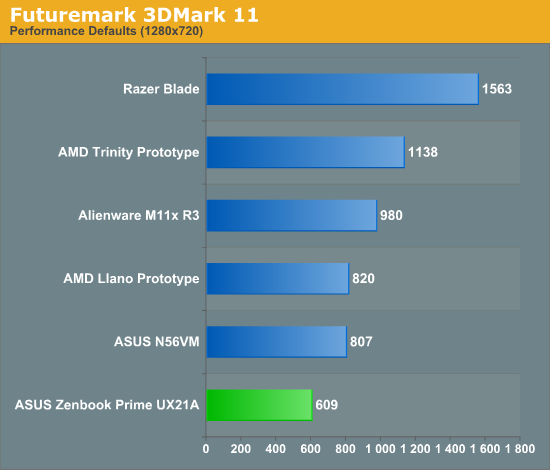
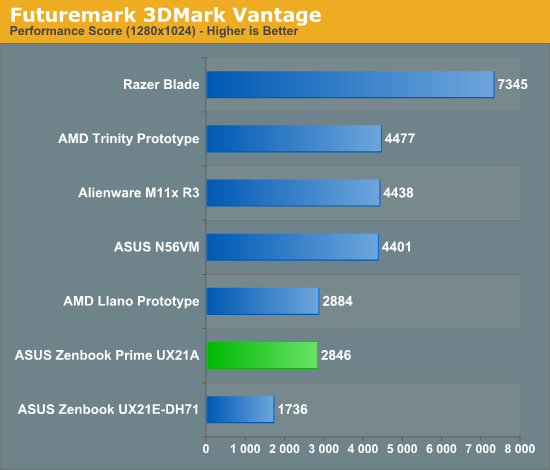
Vantage shows us a 63% improvement over the HD 3000 based Zenbook UX21.
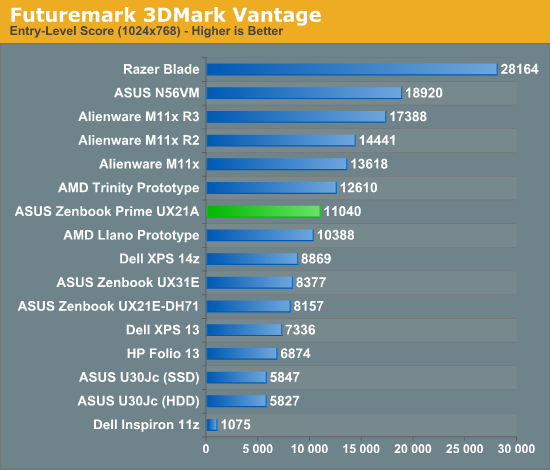
Here we see just how much better Intel's graphics cores have gotten over the years. The Inspiron 11z could barely run the entry level 3DMark Vantage suite, whereas the Zenbook Prime delivers nearly an order of magnitude higher score here.
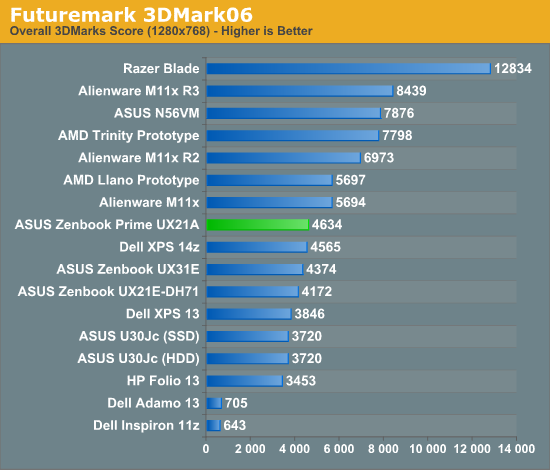
Gaming Performance
We can say that the silicon in the Zenbook Prime's CPU features Intel's HD 4000, the upgraded 16 EU Ivy Bridge GPU. The result should be much improved gaming performance. Once again we are thermally limited so there are some cases where you won't see tremendous increases in performance.
At a high level, for any modern game, you shouldn't count on being able to run it at the Prime's native 1080p resolution. You need a discrete GPU (or Haswell) to pull that off. The former is a tall order for a machine that's already mostly battery. The good news is that 1366 x 768 is playable in many games.
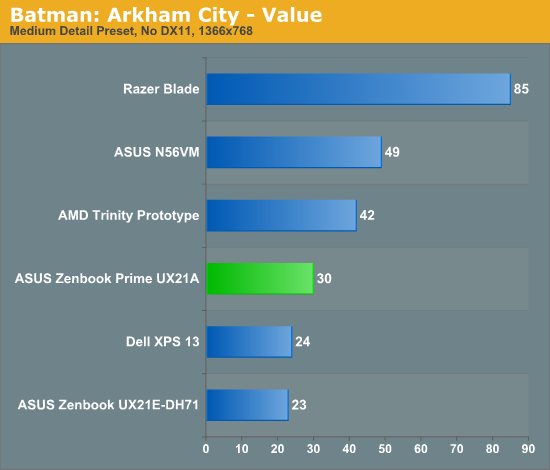
Not all games will see huge performance gains, but the latest Batman title runs 30% quicker on the new Prime.

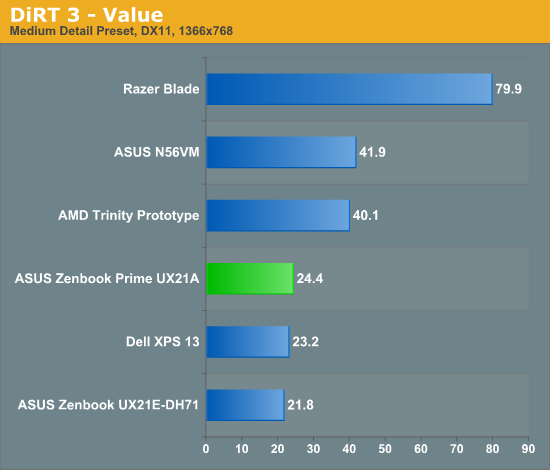
More CPU constrained and thermally bound environments won't show any improvement over the Sandy Bridge based Zenbook UX21.
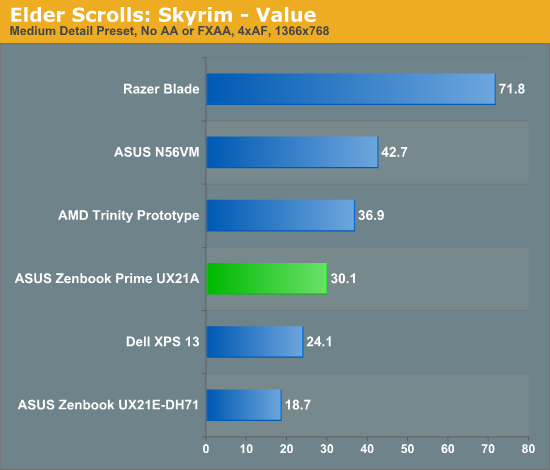
The 61% increase in performance over the original Zenbook takes the Prime into the realm of playability at these settings.

Portal 2 is an interesting case as we are significanty CPU and thermal bound here. The Prime can reach frame rates as high as 39 fps, but after a couple of runs you see degradation into the 32 - 37 fps range. On average, there's no improvement in performance compared to its predecessor - there's no beating the laws of physics.
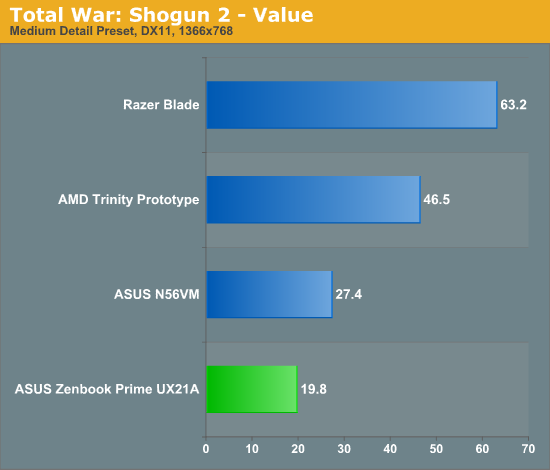
Diablo III
Last week Intel proudly showed me a demonstration of Diablo III running on Ivy Bridge's processor graphics, from a standard notebook all the way down to an Ultrabook. Eager to repeat the experiment myself, I fired up Diablo III on the Zenbook Prime.
Default settings at 1920 x 1080 were understandably unplayable. Dropping the resolution down to 1366 x 768 and clutter density down to medium however gave me an average of around 17 fps outdoors and 20 fps in early crypts. Given that Diablo isn't a twitch shooter, these frame rates were actually playable - all I needed was an external mouse.
As a primary gaming system, any Ultrabook this size is going to fall short. However, if you need to get your Diablo fix in while on the road, the Zenbook Prime will deliver in a pinch.



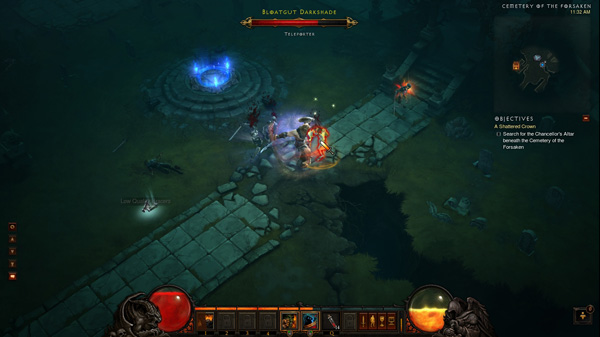








192 Comments
View All Comments
techexperience - Wednesday, May 23, 2012 - link
So, if what I see is correct, (and anand always delivers).The only difference between the Zenbook Prime UX32 $799 and $999 is hardisk space? From 320 GB to 500 GB for $200?By the way great post, Anand, as usual.
http://techexperience.net
ReverendDC - Wednesday, May 23, 2012 - link
I believe that the UX32 is also a little thicker, and the non-DV versions have a dedicated GPU. The hard drives are also platter, not SSD.ReverendDC - Wednesday, May 23, 2012 - link
Sorry, the DV version comes with the dedicated GPU.Reflex - Wednesday, May 23, 2012 - link
Likely a faster CPU as well.UrQuan3 - Wednesday, May 23, 2012 - link
Darn, I went with a Samsung 9 last year and can't afford to replace it yet. 13.3 is too big for me and 1366x768 is too low res. 12" and 1080p would be nice. Looks like an acceptable color gamut as well.Let's not make excuses for poorly written GUIs. They should resize. Games don't have a problem with that.
I do home Microsoft catches their resolution-vs-size mistake on Metro. Last I checked, Metro used fixed sizes and used higher resolutions to put more on the screen instead of allowing app links to resize. They were assuming that high resolution screens are also physically bigger. Of course that would be awful on a small, high res screen. Anyone know if they changed that?
Stanly.ok - Wednesday, May 23, 2012 - link
I look at official Asus slides (particularly at the top of second page) and can't help but wonder ... what kind of marketer or manager made them at the last moment instead of giving this job to a professional?!name99 - Wednesday, May 23, 2012 - link
" In practice I saw a doubling of performance under the same conditions as the original Zenbook (80Mbps vs. ~40Mbps)."This seems really bad. You should have got a doubling from 40MHz 5GHz channels, and a doubling from 2x MIMO. Are you sure the laptop and the base station are both set up optimally (most importantly both are in Greenfield mode so they're not wasting a huge amount of time with g compatibility)?
My 3 yr old MBA gets around 13MB/s to an 18 month old AEBS, and I've seen the new MBAs get around 20MB/s to that AEBS, and I expect even better to the newest AEBS.
IntelUser2000 - Friday, May 25, 2012 - link
I think its the way Anand tests it. On and Macbook Air 2011 review he gets 117Mbps which is 14.6MB/s.dczyz - Wednesday, May 23, 2012 - link
Since we dont have a new MX in the small form factor yet, that UX32VD-DB71 maybe what I do with. Cant wait to see a review on it.agent2099 - Wednesday, May 23, 2012 - link
The main fault I see in this device is the VGA port. They should have included a mini display port to complement the HDMI port. That way you could run two high-resolution displays from the laptop. With my current laptop I have the HDMI out going to the television and I have the mini display port going to my 24 inch monitor.